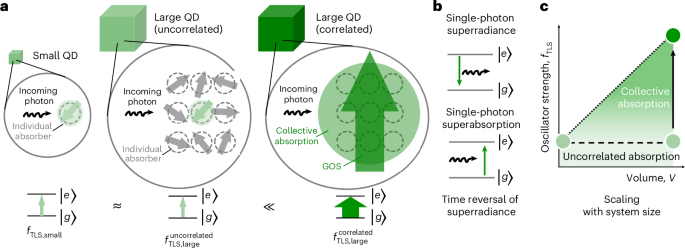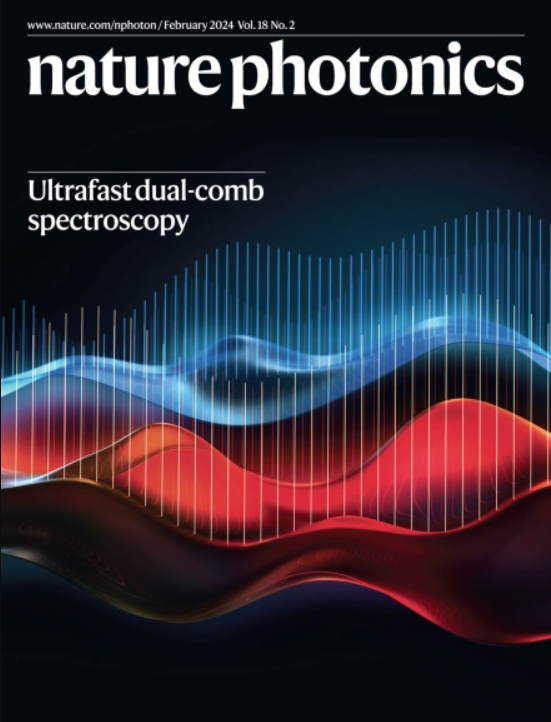Single-photon superabsorption in CsPbBr3 perovskite quantum dots
IF 32.9
1区 物理与天体物理
Q1 OPTICS
引用次数: 0
Abstract
The absorption of light via interband optical transitions plays a key role in nature and applied technology, enabling efficient photosynthesis and photovoltaic cells, fast photodetectors or sensitive (quantum) light–matter interfaces. In many such photonic systems, enhancing the light absorption strength would be beneficial for yielding higher device efficiency and enhanced speed or sensitivity. So far, however, cavity-free light absorbers feature poorly engineerable absorption rates, consistent with the notion that the coupling strength between the initial and final states is an intrinsic material parameter. By contrast, greatly enhanced absorption rates had been theoretically predicted for superradiant systems, which feature giant oscillator strength through spatially extended coherent oscillations of the electron polarization. Unlike for emission processes, however, experimental realizations of superradiance in absorption—‘superabsorption’—remain sparse and require complicated excited-state engineering approaches. Here we report superabsorption by the time reversal of single-photon superradiance in large CsPbBr3 perovskite quantum dots. Optical spectroscopy reveals a bandgap absorption that strongly increases with the quantum dot volume, consistent with a giant exciton wavefunction. Configuration-interaction calculations, quantitatively agreeing with the experiment, attribute the observed single-photon superabsorption to strong electron–hole pair-state correlations. The approach brings new opportunities for the development of more efficient optoelectronic devices and quantum light–matter interfaces. Greatly enhanced light absorption is reported in large perovskite quantum dots by realizing a transition with a giant oscillator strength at the optical bandgap.


CsPbBr3钙钛矿量子点的单光子超吸收
通过带间光学跃迁的光吸收在自然界和应用技术中起着关键作用,可以实现有效的光合作用和光伏电池,快速光电探测器或敏感的(量子)光-物质界面。在许多这样的光子系统中,增强光吸收强度将有利于产生更高的器件效率和增强的速度或灵敏度。然而,到目前为止,无腔光吸收剂具有较差的工程吸收率,这与初始状态和最终状态之间的耦合强度是固有材料参数的概念一致。相比之下,理论上预测了超辐射系统的吸收率大大提高,超辐射系统通过电子极化的空间扩展相干振荡具有巨大的振子强度。然而,与发射过程不同的是,吸收超辐射的实验实现——“超吸收”——仍然很稀疏,需要复杂的激发态工程方法。本文报道了CsPbBr3钙钛矿大量子点中单光子超辐射的时间反转超吸收。光谱学揭示了带隙吸收随着量子点体积的增加而强烈增加,与巨大的激子波函数一致。构型相互作用计算在定量上与实验一致,将观察到的单光子超吸收归因于强电子-空穴对态相关。该方法为开发更高效的光电器件和量子光物质界面带来了新的机遇。
本文章由计算机程序翻译,如有差异,请以英文原文为准。
求助全文
约1分钟内获得全文
求助全文
来源期刊

Nature Photonics
物理-光学
CiteScore
54.20
自引率
1.70%
发文量
158
审稿时长
12 months
期刊介绍:
Nature Photonics is a monthly journal dedicated to the scientific study and application of light, known as Photonics. It publishes top-quality, peer-reviewed research across all areas of light generation, manipulation, and detection.
The journal encompasses research into the fundamental properties of light and its interactions with matter, as well as the latest developments in optoelectronic devices and emerging photonics applications. Topics covered include lasers, LEDs, imaging, detectors, optoelectronic devices, quantum optics, biophotonics, optical data storage, spectroscopy, fiber optics, solar energy, displays, terahertz technology, nonlinear optics, plasmonics, nanophotonics, and X-rays.
In addition to research papers and review articles summarizing scientific findings in optoelectronics, Nature Photonics also features News and Views pieces and research highlights. It uniquely includes articles on the business aspects of the industry, such as technology commercialization and market analysis, offering a comprehensive perspective on the field.
 求助内容:
求助内容: 应助结果提醒方式:
应助结果提醒方式:


